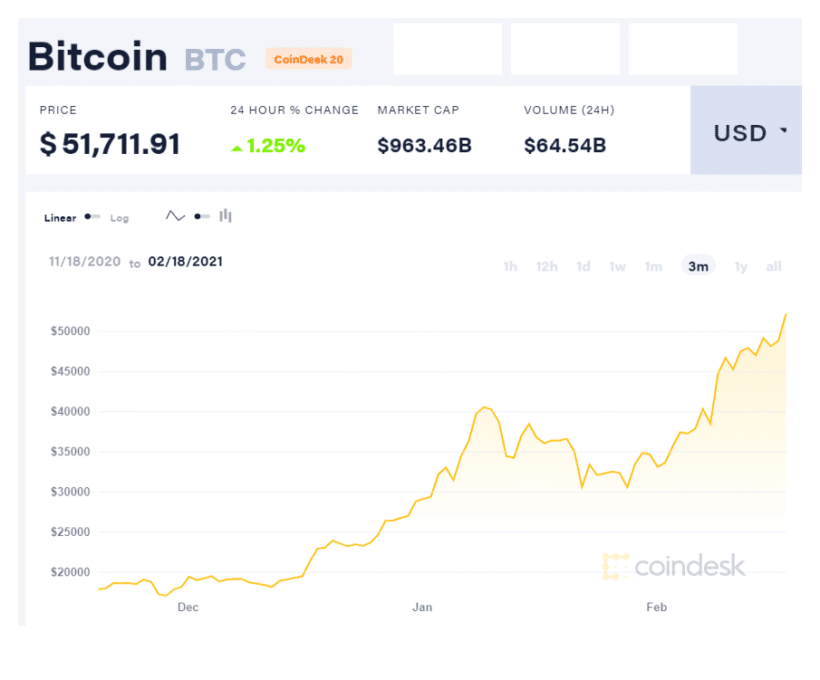
GUANGZHOU, China — Bitcoin could rise to $1 million over the long term to become a reserve currency for the world, according to one asset manager.
But JPMorgan warned of risks ahead as the cryptocurrency continues to rally.
Anthony Pompliano, co-founder and partner at Morgan Creek Digital Assets, said bitcoin could hit $500,000 by the end of the decade. It could eventually reach $1 million per coin, he added, without giving a timeline.
“I think that bitcoin will eventually rise to become the global reserve currency. I think bitcoin will eventually be much much larger than the gold market cap,” he said during the latest episode of CNBC’s “Beyond the Valley” podcast.
Bitcoin has surged over the last few months and surpassed $50,000 for the first time this week.
Why is bitcoin rallying?
A number of factors are behind the rush into bitcoin.
There has been large participation from institutional and retail investors. Major companies are also getting more involved with the cryptocurrency. Square bought some bitcoin last year and Elon Musk’s electric carmaker Tesla purchased around $1.5 billion in bitcoin, according to a filing this month. Musk and Square founder Jack Dorsey are both supporters of bitcoin.

Meanwhile, global central banks have been easing monetary policy — such as lowering interest rates and buying assets through the so-called quantitative easing program —to help cushion the blow to economies hit by the coronavirus pandemic.
“There were trillions of dollars that were printed and injected into the economy and everyone from individuals to financial institutions and corporations ran around the world looking for the best way to protect their purchasing power, they ultimately decided it was bitcoin,” Pompliano said as he discussed what was behind bitcoin’s surge.
(Bitcoin) will eventually take that seat at the kingdom of being that global reserve currency of the internet generation.
Anthony Pompliano MORGAN CREEK DIGITAL ASSETS
The bitcoin bull’s prediction that bitcoin could hit $1 million is based on a few factors including the scarcity of the cryptocurrency which has a cap of 21 million coins, as well as the decentralized nature of the technology.
There is no central authority like a central bank that controls bitcoin.
Instead, the so-called bitcoin network is made up of miners who process transactions. These miners operate a vast array of specialized computers required to carry out the bitcoin mining process.
As there are many different miners, no single entity can control the network. And because the computers they use are often very powerful machines, bitcoin proponents claim the network is one of the strongest computer networks in the world.
“As more and more people come into the market, there is more liquidity. As there is more liquidity, there is more utility. As there’s more utility, there’s more stability in the price … you get kind of this evolution,” Pompliano said.
“If you think about that internet economy, there is no native currency … (bitcoin) will eventually take that seat at the kingdom of being that global reserve currency of the internet generation.”
JPMorgan’s long-term price target for bitcoin
In January, JPMorgan released a note to clients putting a “theoretical” long term price target on bitcoin of $146,000 as bitcoin begins to compete with gold.
Gold is broadly accepted as a “safe haven” asset where investors flock to in times of political strife or financial market turmoil. Bitcoin is now beginning to develop such a reputation.
“Bitcoin is competing with traditional gold, bitcoin is a form of digital gold,” Nikolaos Panigirtzoglou, global markets strategist at JPMorgan, told CNBC’s “Beyond the Valley.”
He said that the value of gold held by the private sector, solely for the purpose of investment, is around $2.7 trillion. For bitcoin’s market cap to reach that, it would need to hit a price of around $146,000.
But there are caveats, the biggest one being the volatility in bitcoin’s price. The digital coin is known for wild swings in price. Panigirtzoglou said bitcoin is “five times more volatility than gold.”
The key to bitcoin’s volatility converging with gold is institutional adoption, the JPMorgan strategist said.
“The faster the pace of institutional adoption, the quicker that convergence in volatility will take place,” he said.
Still, there are risks ahead for the current rally. While it has been driven by institutional investors, retail participation has also been high.
“The biggest risk is that the flow impulse we’ve seen over the past months slows materially from here,” Panigirtzoglou said.
“In particular when the economies reopen, people go back to the office, they have less time to trade at home, and as a result some of that, retail … flow impulse slows from here,” he added.

